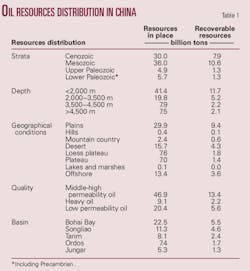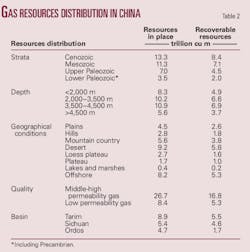The China National Petroleum Assessment (2003-07) evaluated conventional oil and gas resources in 115 Chinese basins.
In these basins, the total oil resources in place are 76.5 billion tons and the total recoverable resources are 21.2 billion tons. Oil resources are mainly distributed in five large basins.
The annual oil production was predicted to exceed 200 million tons before 2015 and keep this level in the next 10 years.
The total natural gas resources in place are 35 trillion cubic meters, and the total recoverable resources are 22 trillion cu m. Gas resources are mainly distributed in three large basins.
The annual natural gas production will exceed 170 billion cu m in 2020 and 230 billion cu m in 2030. By then, gas will have become second in importance in China after coal.
This first of two articles sizes up conventional oil and gas resources in China. A second article will contain an assessment of unconventional oil and gas resources in China.
Introduction
Petroleum is an important energy mineral and strategic resource and has a far-reaching effect on international politics, economy, military, and diplomacy.1 2
It is a persistent policy of the Chinese government to accelerate the development of conventional oil and gas resources, to enhance the utilization of unconventional resources, and to improve the self-supportability of petroleum resources.
From 2003 to 2007, the Ministry of Land and Resources (MLR), National Development and Reform Commission (NDRC), and Ministry of Finance (MOF) organized the China National Petroleum Assessment (2003-07), or CNPA 2007. More than 1,700 workers from five petroleum corporations and 12 geology institutions and colleges participated in the assessment. Compared with the former assessments, CNPA 2007 evaluated both the conventional oil and gas resources in place and recoverable resources.
Oil resources
Resource distribution
CNPA 2007 evaluated conventional oil and gas resources in Chinese 115 basins, including 95 onshore basins and 10 offshore basins.
In these basins, the total oil resources in place are 56.9-105.4 billion tons, with a mean of 76.5 billion tons; and the total recoverable resources are 16.2-28.8 billion tons with a mean of 21.2 billion tons, which is higher than the result of CNPA 1994 of 15 billion tons.3
Table 1 illustrates the distribution of conventional oil resources in China. It shows oil resources distribution in different strata, depth ranges, geographical conditions, qualities, and basins.
Based on the permeability of reservoirs and the density of oil, oil resources can be divided into three types: low permeability oil resources, middle-high permeability oil resources, and heavy oil resources, which account for 63%, 26% and 11% of the total, respectively.
Oil resources are mainly distributed in five large basins, Bohai Bay, Songliao, Tarim, Ordos, and Jungar, and total oil recoverable resources of these basins account for 73% of the countrywide resources.
By yearend 2008, the cumulative proved oil reserves were 7.15 billion tons, the cumulative oil production was 5.02 billion tons, the remaining oil reserves were 2.13 billion tons, and the reserve-production ratio was 11.
Production growth forecast
Owing to the complex geological conditions in China's petroliferous basins, oil exploration and development have the characteristics of being long-term and complex, and the curves of reserves and production growth have multiple peaks.
From 2000 to 2009, the mean yearly proved oil recoverable reserves were more than 170 million tons. The annual proved oil reserves of 180-200 million tons were forecasted to be sustained until 2030.
In 1970, oil production in China was 30.1 million tons. With the development of Daqing oil field and Shengli oil field, oil output increased quickly and reached 103.7 million tons in 1978.
After that, annual oil production grew steadily. From 1979 to 2009, annual oil production of China increased from 105.8 million tons to 189 million tons, with an average annual growth rate of 2%.
In 2009, China was the fourth biggest producing country, just behind Russia, Saudi Arabia, and the US.
The multipeak Hubbert model was used to fit to the oil production growth curve, and the oil production growth from 2010 to 2030 was predicted in China. The annual oil production of the country was predicted to exceed 200 million tons before 2015 and keep this level the next 10 years.
In order to keep oil output steady or grow a little, more investment and more advanced technology will be put into oil exploration and production.
Gas resources
Resource distribution
According to CNPA 2007, the total natural gas resources in place in China are 24.3-49.3 trillion cu m with the mean of 35.0 tcm.
In China, the total recoverable resources are 15.4-31.0 tcm with the mean of 22.0 tcm. The recoverable resources assessed in CNPA 2007 are much higher than the assessment results of CNPA 1994, which were 12.75 tcm.3 The stratum, depth, geographical condition, quality, and basin distributions of gas resources are shown in Table 2.
Based on the permeability of gas reservoirs, gas resources can be divided into two types: low permeability gas resources and middle-high permeability gas resources, the recoverable resources of which account for 76% and 24%, respectively.
Gas resources are more concentrated than oil resources. Gas resources are mainly distributed in three large basins, Tarim, Sichuan, and Ordos, and gas recoverable resources of the three basins account for more than 55% of the countrywide recoverable resources.
Up to the end of 2008, cumulative proved gas reserves were 3.6 × 1012 cu m, cumulative gas production was 0.9 × 1012 cu m, remaining gas reserves were 2.7 × 1012 cu m, and the reserves-production ratio was 35 in China.
Production growth forecast
Exploration for natural gas lags oil exploration by 40 years in China, and large-scale gas exploration started in the early 1990s.4
In the 21st century, many large gas fields were discovered continuously, such as the Kala-2, Sulige, Puguang, and others. And the average yearly proved gas recoverable reserves were more than 0.3 trillion cu m. The annual proved gas reserves were expected to maintain in the next 20 years, and great discoveries like Puguang will be met in the future.
In 1970, gas output in China was 2.9 bcm. From 1970 to 2000, the country's gas output grew slowly and reached 26.2 bcm in 2000. From 2001 to 2009, Chinese gas production increased from 30.3 bcm to 83 bcm, for an average annual growth rate of 13.4%, and took seventh place in the world.
The multipeak Hubbert model was adopted to fit the gas production growth curves, and the gas production growth from 2010 to 2030 was forecasted.
The annual natural gas production was predicted to reach 100 bcm in 2011, exceed 170 bcm in 2020, and attain 220 bcm in 2030. At that time, gas will overtake oil. To achieve the target, China should increase investment in gas exploration and production, and pipeline construction, and price gas at a reasonable level.
Conclusion
China's energy policies can be summarized as follows:
Give high priority to conservation, rely mainly on domestic supply, develop diverse energy resources, protect the environment, step up international cooperation of mutual benefit, and ensure the stable supply of economical and clean energy.
The Chinese government attaches much importance to energy resources and rates the petroleum resource as the key resource influencing the sustainable economic and social development.
China has the resource potential to keep oil production at 200 million tons and gas production at 200 bcm. China will play an important role in world energy market.
References
1. Zhai, G.M., "The prospective hydrocarbon resources of China in 21st Century" (in Chinese), China Petroleum & Chemical, Vol. 23, No. 4, 2002, pp. 271-285.
2. Shen, P.P., Zhao, W.Z., and Dou, L.R., "Oil resources prospects and reserve forecast in China in next decade" (in Chinese), Petroleum Transaction, Vol. 21, No. 4, 2000, pp. 1-6.
3. Zhang, Y.W., "Potentials and Exploration Prospect of China's Hydrocarbon Resources" (in Chinese), Petroleum Science, Vol. 1, No. 1, 2004, pp. 1-7.
4. Qiu, Z.J., and Gong, Z.S., "China Petroleum Exploration" (in Chinese), Petroleum Industry Press, Beijing, 1999, 194 pp.
The authors
Jie Zhu ([email protected]) has been with Strategic Research Center for Oil & Gas Resources of the Ministry of Land and Resources, working on petroleum resources assessment and energy strategy, since 2007. He received a BA in petroleum geosciences and a PhD in geological resources and geological engineering from China University of Petroleum.
Changbo Che ([email protected]) was with Geological Survey Division, Ministry of Land and Resources from 1996 to 2002 and has been with Strategic Research Center for Oil & Gas Resources of the Ministry of Land and Resources working on energy policies and petroleum resources assessment since 2002. He received a BA in economics from NanKai University.
Hulin Yang ([email protected]) was with Geological Survey Division, Ministry of Land and Resources from 1986 to 2001 and has been with Strategic Research Center for Oil & Gas Resources of the Ministry of Land and Resources working on petroleum resources economic assessment and energy strategy since 2001. He received a BA in economics from NanKai University.
Chenglin Liu ([email protected]) was with the Research Institute of Petroleum Exploration and Development, Petrochina, from 1994 to 1999 and has been with China University of Petroleum working on petroleum resources assessment since 2004. He received a BA in petroleum geosciences and a PhD in mineralogy, petrology, and mineral deposit geology from China University of Petroleum.
More Oil & Gas Journal Current Issue Articles
More Oil & Gas Journal Archives Issue Articles
View Oil and Gas Articles on PennEnergy.com





